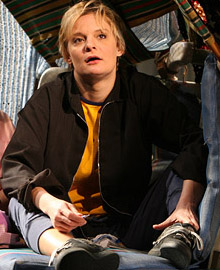
Known for its commitment to "ensemble collaboration and artistic risk through its work with its permanent Ensemble, guest artists, partner institutions and the community," Steppenwolf has an international reputation for edgy playwriting and fierce ensemble acting — the sort of productions where you usually see all of the parts only as they relate to the whole. To put it crudely, in general, star vehicles are not what Steppenwolf is about.
Witness the large-cast, sprawling, dramatic volcano that is the Steppenwolf production of August: Osage County, the already Pulitzer Prize-winning Tracy Letts drama that is up for Tonys in the categories of Best Play, Best Lead Actress in a Play (Deanna Dunagan and Amy Morton), Best Direction of a Play (Anna D. Shapiro) and Best Featured Actress in a Play (Rondi Reed). All but Dunagan are members of the 41-person Steppenwolf Ensemble, which boasts writers, directors and actors.
 |
||
| Martha Plimpton in Top Girls. |
||
| photo by Joan Marcus |
Actor-playwright Letts is a Steppenwolf Ensemble member. Does he have a sense of what's meant by the "Steppenwolf style?" "I think so," Letts told Playbill.com, adding that the idea of "ensemble" is very much in evidence in Chicago in general, not just at Steppenwolf. It just happened that Steppenwolf emerged as a major player there and spawned national stars (John Malkovich, Gary Sinise, Terry Kinney, Metcalf, among others). The troupe tends to be a focal point when looking at the kind of acting/production aesthetic that seems to come naturally in the Windy City.
"I was a member of the Chicago theatre community starting in 1986, and I didn't join this Ensemble until 2002, 2003, something like that," Letts said. "So, I was sort of steeped in the 'Chicago style' or 'storefront' style or 'ensemble acting' or 'Midwest rock 'n' roll theatre' — any of those things you want to call it — before I joined the Ensemble. I don't know, there's something to it."
How does Letts explain "ensemble acting"? "The idea that in a cast of five people, you're looking out for the other four people and that way you've always got four people looking out for you," he said. "That's kind of the ethic that propels us in Chicago. It's what I was taught, it's what I enjoy, it's what I embrace. I'm of the belief that it makes for the best theatre. That's why I'm here, that's why we do it."
How is the style evident in the Broadway production of playwright Letts' family drama August: Osage County?
"I think it's evidenced around that dinner table," Letts said. "I've had a few people comment to me, 'You staged that around the dinner table, where everyone is sitting around the table and you didn't try to open it up so everybody's facing the audience…' I have to say, that was never a consideration, nor did anybody in the cast ever say, 'Oh, are you really sure you wanna do it this way?' nor did anybody sort of jockey for position around the dinner table. They sat where [director] Anna [Shapiro] placed them. Anna and I spent a day moving people around the dinner table trying to get the order around the table just right. Nobody in that cast — not to suggest that there aren't people with tremendous egos and artistic temperaments — nobody in that cast ever questioned it; most of the actors had their backs to the audience, and still do."
Artistic director Martha Lavey told Playbill.com, "It is a question that gets asked of us: What is the Steppenwolf style? In a certain way, collectively, we would all say, 'Yeah, we recognize what you're talking about.' It's just that the palette of work that has been produced here at the theatre is so variable: Everyman, anyone? — the medieval morality play directed by Frank Galati was at our theatre about 10 years ago."
Lavey said that when people refer to "Steppenwolf style," they're talking about work that "broke outside of the theatre." She said, "We're talking about True West with John Malkovich and Gary Sinise; Balm in Gilead, this large ensemble piece; and then we're talking about [the Tony Award-winning] The Grapes of Wrath, which is very much an American populist cry."
Lavey pointed out that many of the Steppenwolf plays are "family-centered."
She said, "Jeff Perry, one of our founding members, who plays Bill in August: Osage County, when he talks about play choices — what became the aesthetic of Steppenwolf — he says, 'We're an ensemble, so we were always looking for ensemble roles for this group, and those tended to be family plays.' A label that gets applied to Steppenwolf is 'home of the dysfunctional family play.' Although as [director of new play development] Ed [Sobel] and I have remarked to each other, you start with the Greeks and then you just go through history…"
Sobel added, "When people write about families that tend to be just functional, there's not much drama in it."
Letts observed, "One of the beautiful things about Steppenwolf is the fact that you're having a hard time putting your finger on it. Because it changes. It changes very gradually, and sometimes it changes immediately, kind of like people do. It's one of the things that has kept the place alive this long. I think as soon as people start to try to codify or regulate it, it's over. I'm glad to see it's still a living, breathing thing and always changing and never predictable."
For more information about Steppenwolf Theatre Company, visit www.steppenwolf.org.
David Hawkanson is Steppenwolf's executive director.
*
Here's a look at how the Tony Awards have embraced Steppenwolf Theatre Company in the past:











